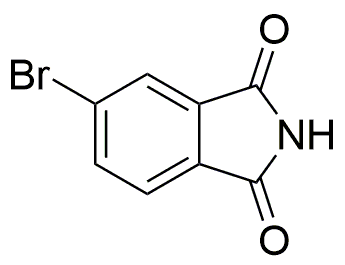4-Bromophthalimide is widely utilized in research focused on:
- Organic Synthesis: This compound serves as a key intermediate in the synthesis of various organic molecules, particularly in the development of pharmaceuticals and agrochemicals.
- Fluorescent Dyes: It is used in the production of fluorescent dyes, which are essential in biological imaging and diagnostics, enhancing visibility in cellular studies.
- Photochemical Applications: The compound is employed in photochemical reactions, making it valuable in the development of light-sensitive materials and coatings.
- Polymer Chemistry: 4-Bromophthalimide is utilized in creating specialty polymers, contributing to the development of materials with unique properties for electronics and coatings.
- Research in Material Science: Its properties make it suitable for studies in material science, particularly in exploring new compounds for electronic and optoelectronic applications.
General Information
Properties
Safety and Regulations
Applications
4-Bromophthalimide is widely utilized in research focused on:
- Organic Synthesis: This compound serves as a key intermediate in the synthesis of various organic molecules, particularly in the development of pharmaceuticals and agrochemicals.
- Fluorescent Dyes: It is used in the production of fluorescent dyes, which are essential in biological imaging and diagnostics, enhancing visibility in cellular studies.
- Photochemical Applications: The compound is employed in photochemical reactions, making it valuable in the development of light-sensitive materials and coatings.
- Polymer Chemistry: 4-Bromophthalimide is utilized in creating specialty polymers, contributing to the development of materials with unique properties for electronics and coatings.
- Research in Material Science: Its properties make it suitable for studies in material science, particularly in exploring new compounds for electronic and optoelectronic applications.
Documents
Safety Data Sheets (SDS)
The SDS provides comprehensive safety information on handling, storage, and disposal of the product.
Product Specification (PS)
The PS provides a comprehensive breakdown of the product’s properties, including chemical composition, physical state, purity, and storage requirements. It also details acceptable quality ranges and the product's intended applications.
Certificates of Analysis (COA)
Search for Certificates of Analysis (COA) by entering the products Lot Number. Lot and Batch Numbers can be found on a product’s label following the words ‘Lot’ or ‘Batch’.
*Catalog Number
*Lot Number
Certificates Of Origin (COO)
This COO confirms the country where the product was manufactured, and also details the materials and components used in it and whether it is derived from natural, synthetic, or other specific sources. This certificate may be required for customs, trade, and regulatory compliance.
*Catalog Number
*Lot Number
Safety Data Sheets (SDS)
The SDS provides comprehensive safety information on handling, storage, and disposal of the product.
DownloadProduct Specification (PS)
The PS provides a comprehensive breakdown of the product’s properties, including chemical composition, physical state, purity, and storage requirements. It also details acceptable quality ranges and the product's intended applications.
DownloadCertificates of Analysis (COA)
Search for Certificates of Analysis (COA) by entering the products Lot Number. Lot and Batch Numbers can be found on a product’s label following the words ‘Lot’ or ‘Batch’.
*Catalog Number
*Lot Number
Certificates Of Origin (COO)
This COO confirms the country where the product was manufactured, and also details the materials and components used in it and whether it is derived from natural, synthetic, or other specific sources. This certificate may be required for customs, trade, and regulatory compliance.


